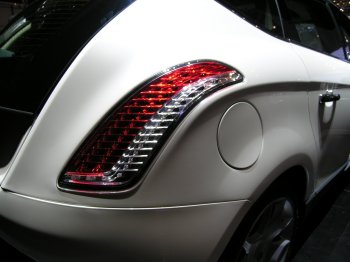
 |
With the entire Lancia stand given over to
the premiere of the Delta on press day,
there was no doubt about the significance of
the new midsizer in helping to turn around
the marque’s fortunes. |
|
 |
|
|
|
With the
entire Lancia stand given over to the premiere of the
Delta on press day, there was no doubt about the
significance of the new midsizer in helping to turn
around the historic marque’s fortunes. As the brand’s
first all-new model in half a decade, there was a
definite sense of anticipation about the car, which is
set to re-establish Lancia in the crucial C- and
D-segments, as well as spearhead its push into
right-hand drive markets it abandoned over a decade ago.
Lancia expects
to sell around 70,000 Deltas per year, an integral part of
their aim to push towards a goal of 300,000 sales by
2010. Moreover, in addition to the sales that the Delta will
generate by itself, Lancia expects that increased showroom
traffic will also boost sales of its existing range of
Ypsilon, Musa, Thesis and Phedra models.
Of those 70,000
cars, around half are allocated towards the Italian market,
while a further 25,000 are destined for the rest of Europe,
including Lancia’s long-awaited return to the UK. The final
10,000 are expected to be sold outside Europe, in markets
such as Japan and Australia, which Lancia is also expected
to return to over the next few years.
After a
spectacular launch display, Lancia opened the cars up for
public inspection. Reflecting the colour scheme of the
stand itself, three of the cars on display were finished in
a (presently very fashionable) pastel white, with
contrasting two-tone ‘nero opaco’ finish on the roof
pillars. All three of these examples were also fitted with
the ‘Granluce’ glass roof, and the 18-inch Sport wheel
option. Joining them on the stand were two contrasting cars
in black, again with the nero opaco roof finish, fitted with
the 17-inch spoked wheels to be fitted as standard on Oro
and Platino specification cars and optional on Argento
models.
Garnering much
media attention, the cars looked impressive up close, with
many observers commenting positively on the cars’
well-judged aesthetic. Particularly notable is the ‘floating
roof’ which melds well with the two-tone paint, and the
claw-shaped headlamps, which give the front a powerful and
distinctive look. The high standards were kept up inside,
with plush materials evident on the cars on display,
particularly in the trimmings and dashboard, which feels a
cut above the car from which it is derived, the Fiat
Bravo. Overall, the impression is of a solid contender which
brings a much-needed dose of style and substance to the
class.
|